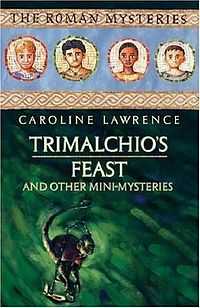Trimalchio's Feast and other mini-mysteries
|
First edition cover | |
| Author | Caroline Lawrence |
|---|---|
| Cover artist |
Peter Sutton, Fred van Deelen |
| Country | United Kingdom |
| Language | English |
| Series | The Roman Mysteries |
| Genre |
Short stories Historical fiction |
| Publisher | Orion Books |
Publication date | 7 June 2007 |
| Media type | Print (Paperback) |
| Pages | 144 pp (first edition) |
| ISBN | 1-84255-593-6 |
| OCLC | 84998604 |
Trimalchio's Feast and other mini-mysteries is a collection of stories by Caroline Lawrence, published in 2007 as part of the Roman Mysteries series. The stories are set in Ostia and Rome between AD 79 and AD 81, in the intervals of time between the novels. In addition to the stories, the author includes a brief account of how she came to write each one, and at the end is an interview with Jon Appleton in which she talks about the secrets of writing mysteries.
The stories
The Case of the Missing Coin
This is a solo Flavia adventure, set between the first and second novels. Flavia solves the case based purely on a description of the crime scene. Pandora, the ill-treated daughter of a poor Roman, comes to Flavia for help, convinced her father's scheming slave girl has stolen a coin Pandora's father gave her to go shopping, and Pandora fears her father's wrath. Flavia listens to Pandora's description of her room, and concludes that the slave girl has hidden the coin in her lamp. Pandora returns delightedly the next day to say that Flavia was right, and the slave girl has been sold as punishment.
Trimalchio's Feast
This is an account of Lupus's disastrous birthday party, mentioned in The Enemies of Jupiter, and the events leading up to it. It explains why Lupus has no pet, although at one time he had three. The title is an allusion to the Roman text Cena Trimalchionis, part of the Satyricon, although the Trimalchio in this story is a monkey.
Jonathan vs. Ira
This is a first-person narrative, in diary form, and recounts the feelings and experiences of Jonathan when he was training as a gladiator in Rome after the events of The Enemies of Jupiter.
The Case of the Citrus-Wood Table
This mini-mystery takes place in April AD 80, between The Gladiators of Capua and The Colossus of Rhodes. Flavia is hot on the search for clues when a surprisingly valuable table disappears, but Jonathan solves the case.
The Case of the Talking Statue
The longest of the stories, this mystery is set in October AD 80, between The Charioteer of Delphi and The Slave-girl from Jerusalem, at a time of political campaigning in Ostia. It begins when Alma hears a cult statue in the shrine of Spes say: "Hope will blossom when Ostia picks the crocus". While reserving judgement about whether a god could be talking through the statue, the detectives investigate other possible explanations for the prodigy.
Death by Vespasian
This story is in the form of a draft of a report from Bato to the Emperor Titus. While the eventual report would clearly be an example of an unreliable narrator, a more honest story emerges through the crossings-out. As Bato admits, the case is a good example of the four friends working together to solve a mystery - in this case, the shocking murder of a Roman senator. The story is set after The Slave-girl from Jerusalem; Bato makes a reference to his testimony in court and the new house it earned him. Bato also comments on Mordecai's broken appearance, though seeming unaware of his daughter's death. Bato's report apparently helped Titus to decide to send the children on the quest for the emerald, in The Beggar of Volubilis.
External links
| ||||||||||||||||||||||||||||||
